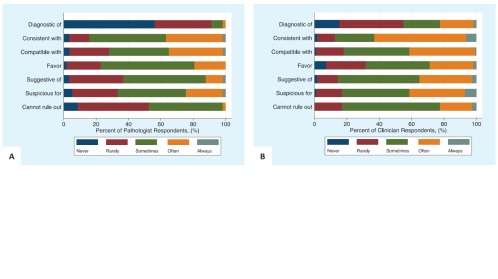The Use of Hedge Phrases in Histopathology Reports by Filipino Pathologists and Clinicians’ Interpretation of Them
DOI:
https://doi.org/10.21141/PJP.2023.19Keywords:
communication, diagnostic uncertainty, hedge phrases, histopathology reports, pathology reports, uncertaintyAbstract
Introduction. When communicating uncertainty in histopathology reports, pathologists often use hedge phrases (HPs) to qualify their diagnoses, assuming that clinicians understand their meaning. However, Western studies have shown that these phrases have remarkable variations in intended and perceived certainty, which may impact the next steps of patient care.
Objectives. For seven commonly used HPs, we aimed to determine: how frequently these are used and encountered in histopathology reports in the Philippine setting; if there are differences in certainty among the phrases as well as between the intended and perceived certainty by pathologists and clinicians, respectively; the frequency of seeking clarification for each phrase, the preferred mode of communication, and the frequency that the next steps of patient management are taken for each phrase.
Methodology. Through snowball sampling, 57 pathologists and 111 clinicians from different geographic regions in the Philippines were recruited for an online survey. For each HP, participants reported the frequency of use of or encounter, rated percentage certainty, and answered questions regarding frequency of clarification, next step of management, and preferred mode of communication. Differences between intended and perceived certainty were determined by the Mann-Whitney U test. Differences in certainty among HPs were determined by the Kruskal-Wallis H test with the post-hoc Dunn test.
Results. The phrases “consistent with” and “diagnostic of” were the most and least frequent HPs, respectively. Certainty was perceived to be lower than intended for the phrase “cannot rule out” and for when no HP is used. Differences in certainty were found among most of the HPs. “Diagnostic of” and “consistent with” showed high certainty, “compatible with” and “favor” showed moderate certainty, “suggestive of” and “suspicious for” showed fair certainty, and “cannot rule out” had low certainty.
Conclusion. The variability of intended and perceived certainty for different HPs may warrant standardization of usage in reporting to prevent potential miscommunication and misinterpretation.
Downloads
References
Hanauer DA, Liu Y, Mei Q, Manion FJ, Balis UJ, Zheng K. Hedging their mets: the use of uncertainty terms in clinical documents and its potential implications when sharing the documents with patients. AMIA Annu Symp Proc. 2012;2012:321-30. https://pubmed.ncbi.nlm.nih.gov/23304302. https://www.ncbi.nlm.nih.gov/pmc/articles/PMC3540426.
Amin A, DeLellis RA, Fava JL. Modifying phrases in surgical pathology reports: introduction of Standardized Scheme of Reporting Certainty in Pathology Reports (SSRC‑Path). Virchows Archiv. 2021;479(5):1021-9. https://pubmed.ncbi.nlm.nih.gov/34272982. https://doi.org/10.1007/s00428-021-03155-w. DOI: https://doi.org/10.1007/s00428-021-03155-w
Gibson BA, McKinnon E, Bentley RC, et al. Communicating certainty in pathology reports. Arch Pathol Lab Med. 2022;146(7):886-93. https://pubmed.ncbi.nlm.nih.gov/34669920. https://doi.org/10.5858/arpa.2020-0761-OA. DOI: https://doi.org/10.5858/arpa.2020-0761-OA
Lindley SW, Gillies EM, Hassell LA. Communicating diagnostic uncertainty in surgical pathology reports: disparities between sender and receiver. Pathol Res Pract. 2014;210(10):628-33. 10.1007/s00428-021-03155-w.24939143. https://doi.org/10.1016/j.prp.2014.04.006. DOI: https://doi.org/10.1016/j.prp.2014.04.006
Galloway M, Taiyeb T. The interpretation of phrases used to describe uncertainty in pathology reports. Patholog Res Int. 2011;2011:656079. https://pubmed.ncbi.nlm.nih.gov/21876845. https://www.ncbi.nlm.nih.gov/pmc/articles/PMC3160107. https://doi.org/10.4061/2011/656079. DOI: https://doi.org/10.4061/2011/656079
Attanoos RL, Bull AD, Douglas-Jones AG, Fligelstone LJ, Semararo D. Phraseology in pathology reports: a comparative study of interpretation among pathologists and surgeons. J Clin Pathol. 1996;49(1):79-81. https://pubmed.ncbi.nlm.nih.gov/8666692. https://www.ncbi.nlm.nih.gov/pmc/articles/PMC1023163. https://doi.org/10.1136/jcp.49.1.79. DOI: https://doi.org/10.1136/jcp.49.1.79
Bracamonte E, Gibson BA, Lein R, Krupinski EA, Weinstein RS. Communicating uncertainty in surgical pathology reports: a survey of staff physicians and residents at an academic medical center. Acad Pathol. 2016;3:2374289516659079. https://pubmed.ncbi.nlm.nih.gov/28725774. https://www.ncbi.nlm.nih.gov/pmc/articles/PMC5497900. https://doi.org/10.1177/2374289516659079. DOI: https://doi.org/10.1177/2374289516659079
Smith SM, Yearsley M. Constructing comments in a pathology report: advice for the pathology resident. Arch Pathol Lab Med. 2016;140(10):1023-4. https://pubmed.ncbi.nlm.nih.gov/27684971. https://doi.org/10.5858/arpa.2016-0220-ED. DOI: https://doi.org/10.5858/arpa.2016-0220-ED
Ali S, Vanderlaan P, eds. The Bethesda System for reporting thyroid cytopathology, 3rd ed. Springer; 2023. DOI: https://doi.org/10.1007/978-3-031-28046-7
Idowu M, Wiles A, Wen W, Wilkinson DS, Powers CN. Equivocal or ambiguous terminologies in pathology: focus of continuous quality improvement? Am J Surg Pathol. 2013;37(11):1722–7. https://pubmed.ncbi.nlm.nih.gov/23887162. https://doi.org/10.1097/PAS.0b013e318297304f. DOI: https://doi.org/10.1097/PAS.0b013e318297304f
Faquin W, Rossi E, Baloch Z, et al., eds. The Milan system for reporting salivary gland cytopathology. Cham, Switzerland: Springer; 2018. DOI: https://doi.org/10.1007/978-3-319-71285-7

Downloads
Published
How to Cite
Issue
Section
License
Copyright (c) 2023 PJP

This work is licensed under a Creative Commons Attribution-NonCommercial-ShareAlike 4.0 International License.








